Leadership and Management in Operations: A Report for M&S
VerifiedAdded on 2023/01/11
|17
|4439
|34
Report
AI Summary
This report provides a comprehensive analysis of leadership and management within the context of M&S, a multinational British retail organization. It begins by defining and differentiating the roles and characteristics of leaders and managers, exploring the differences in their vision-setting, relationship-building, and coaching approaches. The report then examines how these roles are applied in various situational contexts, emphasizing the importance of leadership in driving organizational change and the manager's role in setting goals and facilitating processes. Furthermore, the report delves into different leadership theories and models, including situational, system, and contingency leadership, and explores the application of hard and soft management skills. The report also discusses approaches to operational management, such as lean manufacturing, and highlights the importance of operations management in achieving business objectives. Finally, it analyzes the factors within the business environment that impact operational management and decision-making by leaders and managers, providing a holistic view of leadership and management practices within M&S.
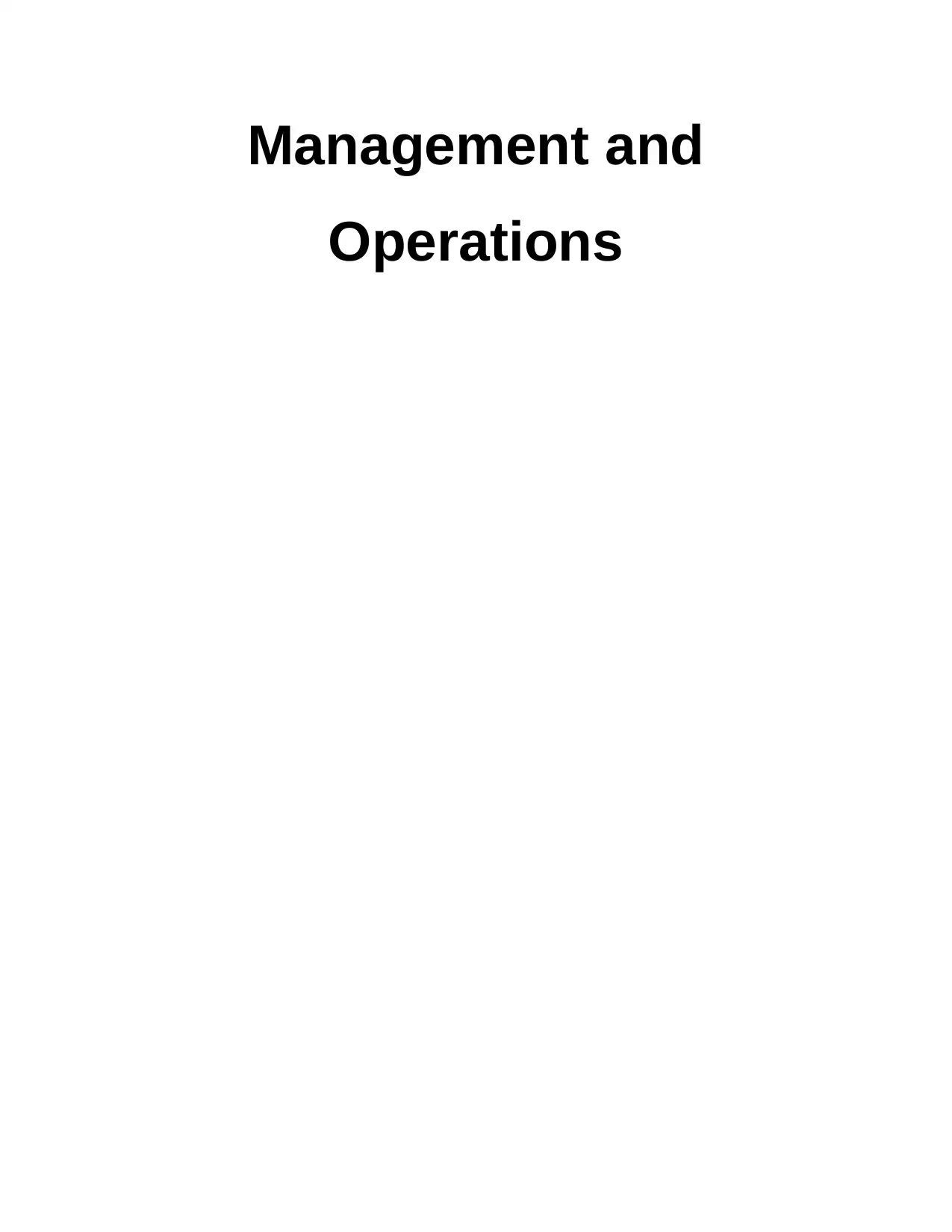
Management and
Operations
Operations
Paraphrase This Document
Need a fresh take? Get an instant paraphrase of this document with our AI Paraphraser
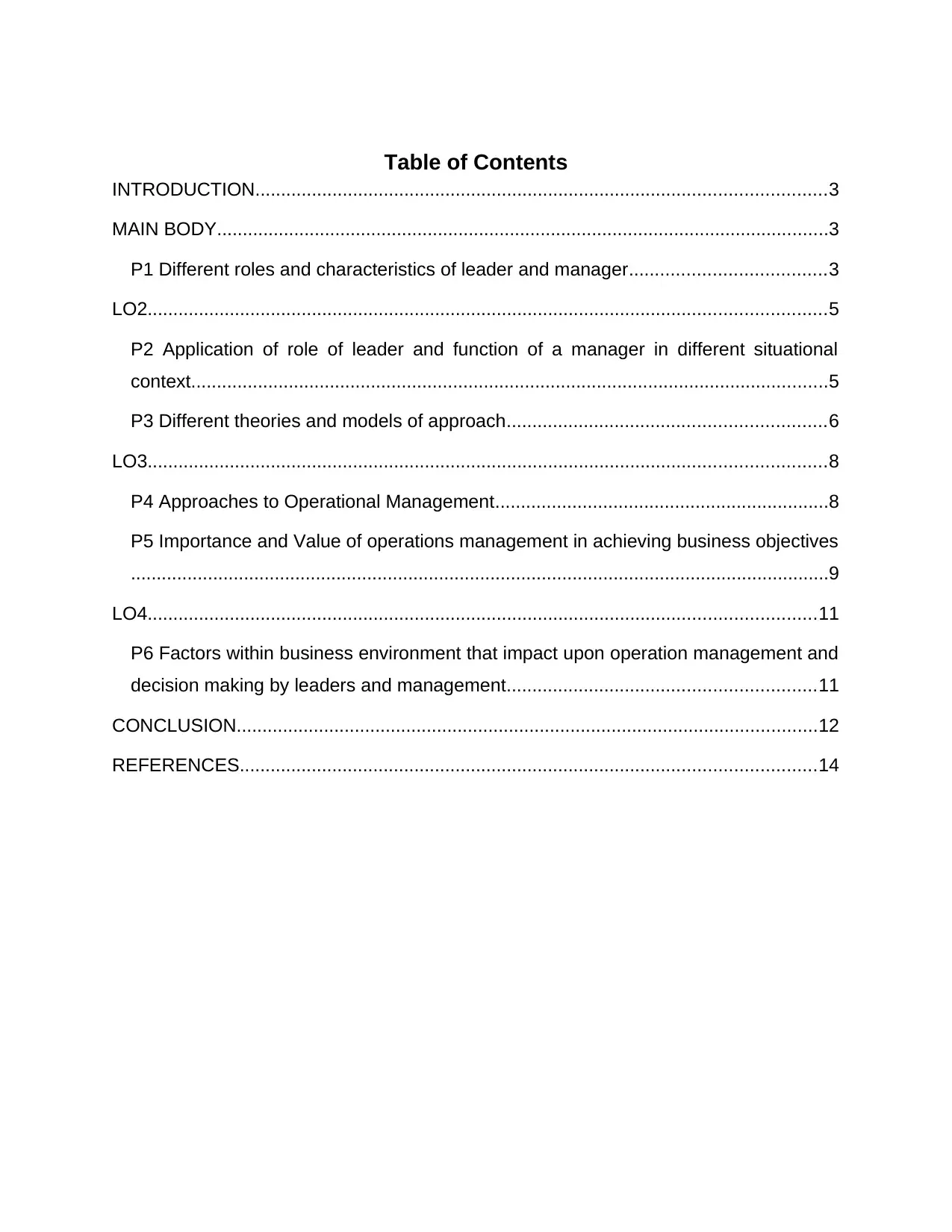
Table of Contents
INTRODUCTION...............................................................................................................3
MAIN BODY.......................................................................................................................3
P1 Different roles and characteristics of leader and manager......................................3
LO2....................................................................................................................................5
P2 Application of role of leader and function of a manager in different situational
context............................................................................................................................5
P3 Different theories and models of approach..............................................................6
LO3....................................................................................................................................8
P4 Approaches to Operational Management.................................................................8
P5 Importance and Value of operations management in achieving business objectives
........................................................................................................................................9
LO4..................................................................................................................................11
P6 Factors within business environment that impact upon operation management and
decision making by leaders and management............................................................11
CONCLUSION.................................................................................................................12
REFERENCES................................................................................................................14
INTRODUCTION...............................................................................................................3
MAIN BODY.......................................................................................................................3
P1 Different roles and characteristics of leader and manager......................................3
LO2....................................................................................................................................5
P2 Application of role of leader and function of a manager in different situational
context............................................................................................................................5
P3 Different theories and models of approach..............................................................6
LO3....................................................................................................................................8
P4 Approaches to Operational Management.................................................................8
P5 Importance and Value of operations management in achieving business objectives
........................................................................................................................................9
LO4..................................................................................................................................11
P6 Factors within business environment that impact upon operation management and
decision making by leaders and management............................................................11
CONCLUSION.................................................................................................................12
REFERENCES................................................................................................................14
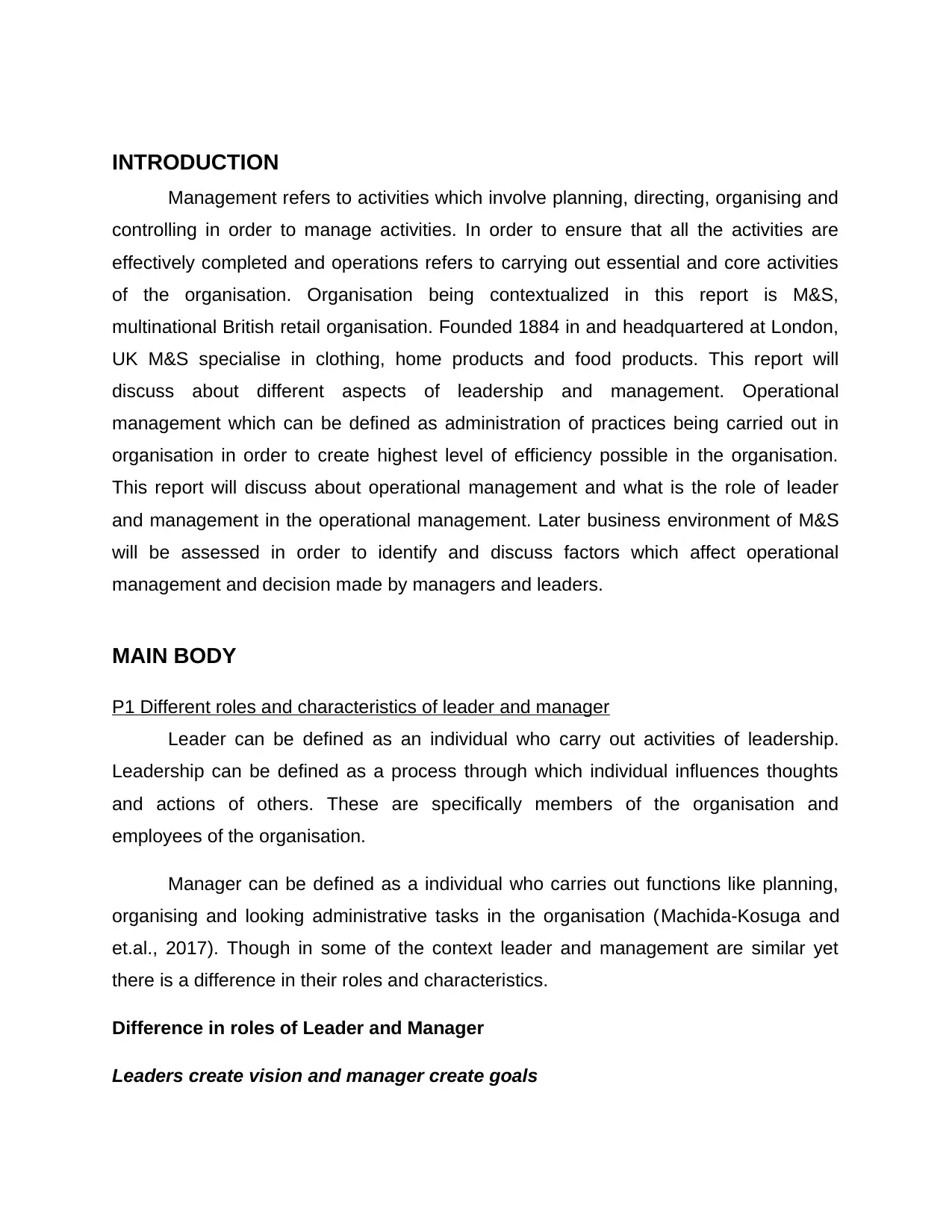
INTRODUCTION
Management refers to activities which involve planning, directing, organising and
controlling in order to manage activities. In order to ensure that all the activities are
effectively completed and operations refers to carrying out essential and core activities
of the organisation. Organisation being contextualized in this report is M&S,
multinational British retail organisation. Founded 1884 in and headquartered at London,
UK M&S specialise in clothing, home products and food products. This report will
discuss about different aspects of leadership and management. Operational
management which can be defined as administration of practices being carried out in
organisation in order to create highest level of efficiency possible in the organisation.
This report will discuss about operational management and what is the role of leader
and management in the operational management. Later business environment of M&S
will be assessed in order to identify and discuss factors which affect operational
management and decision made by managers and leaders.
MAIN BODY
P1 Different roles and characteristics of leader and manager
Leader can be defined as an individual who carry out activities of leadership.
Leadership can be defined as a process through which individual influences thoughts
and actions of others. These are specifically members of the organisation and
employees of the organisation.
Manager can be defined as a individual who carries out functions like planning,
organising and looking administrative tasks in the organisation (Machida-Kosuga and
et.al., 2017). Though in some of the context leader and management are similar yet
there is a difference in their roles and characteristics.
Difference in roles of Leader and Manager
Leaders create vision and manager create goals
Management refers to activities which involve planning, directing, organising and
controlling in order to manage activities. In order to ensure that all the activities are
effectively completed and operations refers to carrying out essential and core activities
of the organisation. Organisation being contextualized in this report is M&S,
multinational British retail organisation. Founded 1884 in and headquartered at London,
UK M&S specialise in clothing, home products and food products. This report will
discuss about different aspects of leadership and management. Operational
management which can be defined as administration of practices being carried out in
organisation in order to create highest level of efficiency possible in the organisation.
This report will discuss about operational management and what is the role of leader
and management in the operational management. Later business environment of M&S
will be assessed in order to identify and discuss factors which affect operational
management and decision made by managers and leaders.
MAIN BODY
P1 Different roles and characteristics of leader and manager
Leader can be defined as an individual who carry out activities of leadership.
Leadership can be defined as a process through which individual influences thoughts
and actions of others. These are specifically members of the organisation and
employees of the organisation.
Manager can be defined as a individual who carries out functions like planning,
organising and looking administrative tasks in the organisation (Machida-Kosuga and
et.al., 2017). Though in some of the context leader and management are similar yet
there is a difference in their roles and characteristics.
Difference in roles of Leader and Manager
Leaders create vision and manager create goals
⊘ This is a preview!⊘
Do you want full access?
Subscribe today to unlock all pages.

Trusted by 1+ million students worldwide
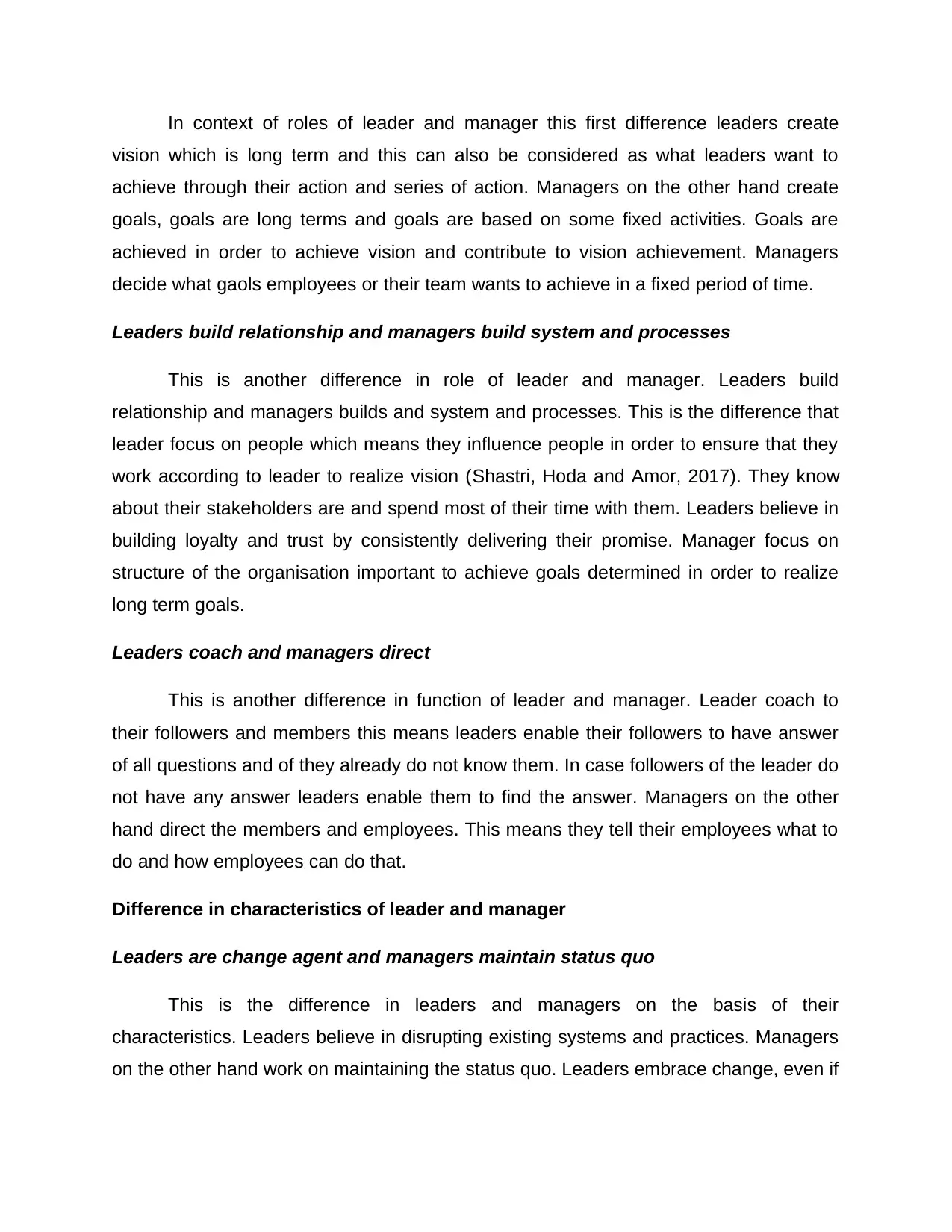
In context of roles of leader and manager this first difference leaders create
vision which is long term and this can also be considered as what leaders want to
achieve through their action and series of action. Managers on the other hand create
goals, goals are long terms and goals are based on some fixed activities. Goals are
achieved in order to achieve vision and contribute to vision achievement. Managers
decide what gaols employees or their team wants to achieve in a fixed period of time.
Leaders build relationship and managers build system and processes
This is another difference in role of leader and manager. Leaders build
relationship and managers builds and system and processes. This is the difference that
leader focus on people which means they influence people in order to ensure that they
work according to leader to realize vision (Shastri, Hoda and Amor, 2017). They know
about their stakeholders are and spend most of their time with them. Leaders believe in
building loyalty and trust by consistently delivering their promise. Manager focus on
structure of the organisation important to achieve goals determined in order to realize
long term goals.
Leaders coach and managers direct
This is another difference in function of leader and manager. Leader coach to
their followers and members this means leaders enable their followers to have answer
of all questions and of they already do not know them. In case followers of the leader do
not have any answer leaders enable them to find the answer. Managers on the other
hand direct the members and employees. This means they tell their employees what to
do and how employees can do that.
Difference in characteristics of leader and manager
Leaders are change agent and managers maintain status quo
This is the difference in leaders and managers on the basis of their
characteristics. Leaders believe in disrupting existing systems and practices. Managers
on the other hand work on maintaining the status quo. Leaders embrace change, even if
vision which is long term and this can also be considered as what leaders want to
achieve through their action and series of action. Managers on the other hand create
goals, goals are long terms and goals are based on some fixed activities. Goals are
achieved in order to achieve vision and contribute to vision achievement. Managers
decide what gaols employees or their team wants to achieve in a fixed period of time.
Leaders build relationship and managers build system and processes
This is another difference in role of leader and manager. Leaders build
relationship and managers builds and system and processes. This is the difference that
leader focus on people which means they influence people in order to ensure that they
work according to leader to realize vision (Shastri, Hoda and Amor, 2017). They know
about their stakeholders are and spend most of their time with them. Leaders believe in
building loyalty and trust by consistently delivering their promise. Manager focus on
structure of the organisation important to achieve goals determined in order to realize
long term goals.
Leaders coach and managers direct
This is another difference in function of leader and manager. Leader coach to
their followers and members this means leaders enable their followers to have answer
of all questions and of they already do not know them. In case followers of the leader do
not have any answer leaders enable them to find the answer. Managers on the other
hand direct the members and employees. This means they tell their employees what to
do and how employees can do that.
Difference in characteristics of leader and manager
Leaders are change agent and managers maintain status quo
This is the difference in leaders and managers on the basis of their
characteristics. Leaders believe in disrupting existing systems and practices. Managers
on the other hand work on maintaining the status quo. Leaders embrace change, even if
Paraphrase This Document
Need a fresh take? Get an instant paraphrase of this document with our AI Paraphraser
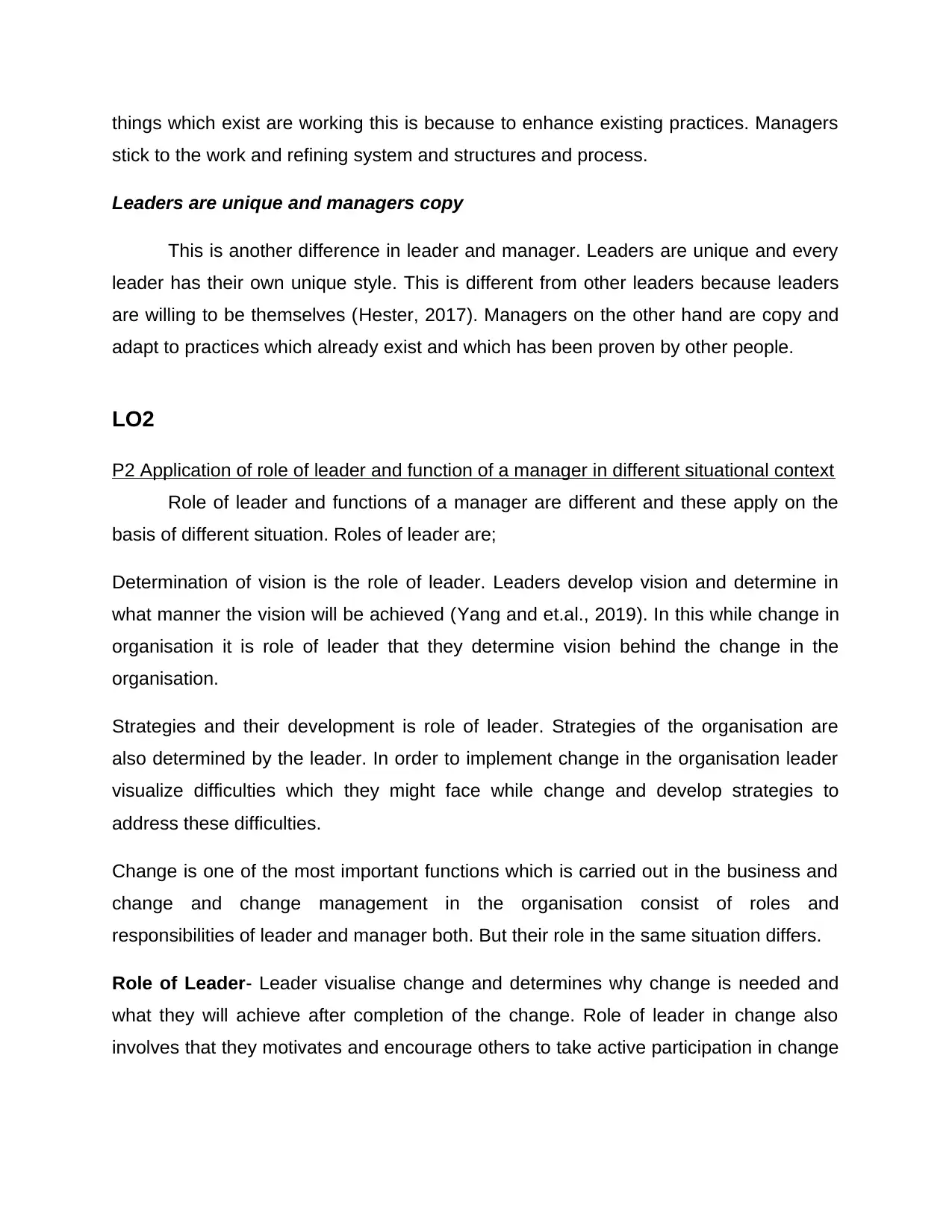
things which exist are working this is because to enhance existing practices. Managers
stick to the work and refining system and structures and process.
Leaders are unique and managers copy
This is another difference in leader and manager. Leaders are unique and every
leader has their own unique style. This is different from other leaders because leaders
are willing to be themselves (Hester, 2017). Managers on the other hand are copy and
adapt to practices which already exist and which has been proven by other people.
LO2
P2 Application of role of leader and function of a manager in different situational context
Role of leader and functions of a manager are different and these apply on the
basis of different situation. Roles of leader are;
Determination of vision is the role of leader. Leaders develop vision and determine in
what manner the vision will be achieved (Yang and et.al., 2019). In this while change in
organisation it is role of leader that they determine vision behind the change in the
organisation.
Strategies and their development is role of leader. Strategies of the organisation are
also determined by the leader. In order to implement change in the organisation leader
visualize difficulties which they might face while change and develop strategies to
address these difficulties.
Change is one of the most important functions which is carried out in the business and
change and change management in the organisation consist of roles and
responsibilities of leader and manager both. But their role in the same situation differs.
Role of Leader- Leader visualise change and determines why change is needed and
what they will achieve after completion of the change. Role of leader in change also
involves that they motivates and encourage others to take active participation in change
stick to the work and refining system and structures and process.
Leaders are unique and managers copy
This is another difference in leader and manager. Leaders are unique and every
leader has their own unique style. This is different from other leaders because leaders
are willing to be themselves (Hester, 2017). Managers on the other hand are copy and
adapt to practices which already exist and which has been proven by other people.
LO2
P2 Application of role of leader and function of a manager in different situational context
Role of leader and functions of a manager are different and these apply on the
basis of different situation. Roles of leader are;
Determination of vision is the role of leader. Leaders develop vision and determine in
what manner the vision will be achieved (Yang and et.al., 2019). In this while change in
organisation it is role of leader that they determine vision behind the change in the
organisation.
Strategies and their development is role of leader. Strategies of the organisation are
also determined by the leader. In order to implement change in the organisation leader
visualize difficulties which they might face while change and develop strategies to
address these difficulties.
Change is one of the most important functions which is carried out in the business and
change and change management in the organisation consist of roles and
responsibilities of leader and manager both. But their role in the same situation differs.
Role of Leader- Leader visualise change and determines why change is needed and
what they will achieve after completion of the change. Role of leader in change also
involves that they motivates and encourage others to take active participation in change

and through which they can achieve the desired change. This means that developing
and establishing relationship is another role of leader in M&S.
Role of Manager- Role of manager in change is different from leader and role of
manager is determines smart goals and objectives for the employees. Developing
system and facilitating processes is also role and responsibility of the manager. this
ensures that process of the change is effectively carried out.
P3 Different theories and models of approach
Leadership is various approaches these approaches refer to style and manner in
which leader carry out their leadership. There are several approaches of leadership and
some of them are as follows;
Situational Leadership
This leadership approach involves a leadership style of leader in which
leadership is adaptive according to situation. Situation involves competency and
willingness of members (Lynch and et.al., 2018). Applying this leadership approach in
M&S leaders will require identifying competency of their members and what is their
motivation level and on the basis of that leaders can apply any leadership style among
Telling, Selling, Participating and Delegating.
Telling style means giving specific guidelines and close supervision of members
Selling style means explaining members about the task and persuading them to
complete it.
Participating style involves sharing and facilitating members. Sharing refers to
sharing information and facilitating them so that they complete the task.
Delegating style means delegating the task to members so that they can
complete it according to their competency.
Before applying this leaders in M&S will require to identify at what level of readiness the
members are so that they can adapt right kind of style for leadership.
and establishing relationship is another role of leader in M&S.
Role of Manager- Role of manager in change is different from leader and role of
manager is determines smart goals and objectives for the employees. Developing
system and facilitating processes is also role and responsibility of the manager. this
ensures that process of the change is effectively carried out.
P3 Different theories and models of approach
Leadership is various approaches these approaches refer to style and manner in
which leader carry out their leadership. There are several approaches of leadership and
some of them are as follows;
Situational Leadership
This leadership approach involves a leadership style of leader in which
leadership is adaptive according to situation. Situation involves competency and
willingness of members (Lynch and et.al., 2018). Applying this leadership approach in
M&S leaders will require identifying competency of their members and what is their
motivation level and on the basis of that leaders can apply any leadership style among
Telling, Selling, Participating and Delegating.
Telling style means giving specific guidelines and close supervision of members
Selling style means explaining members about the task and persuading them to
complete it.
Participating style involves sharing and facilitating members. Sharing refers to
sharing information and facilitating them so that they complete the task.
Delegating style means delegating the task to members so that they can
complete it according to their competency.
Before applying this leaders in M&S will require to identify at what level of readiness the
members are so that they can adapt right kind of style for leadership.
⊘ This is a preview!⊘
Do you want full access?
Subscribe today to unlock all pages.

Trusted by 1+ million students worldwide
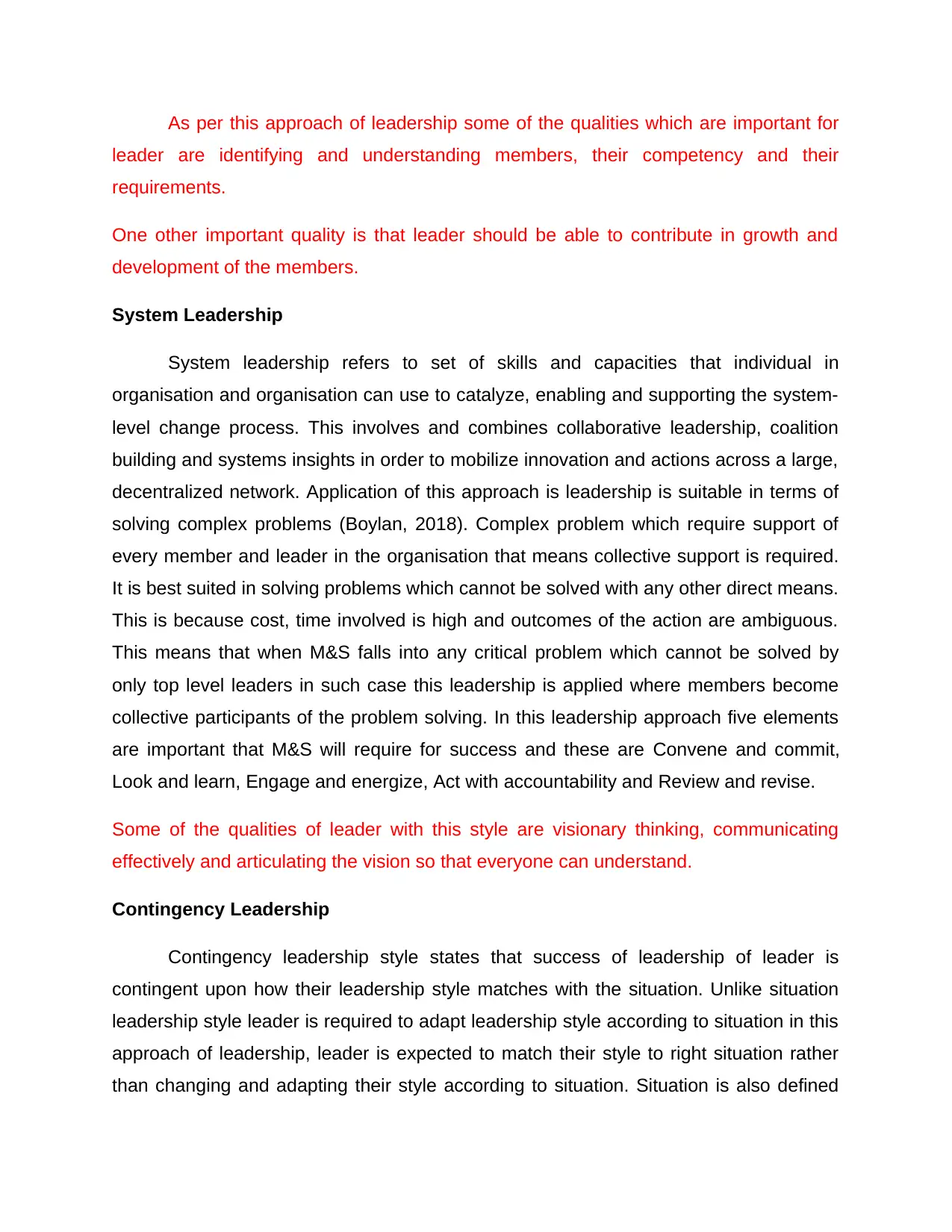
As per this approach of leadership some of the qualities which are important for
leader are identifying and understanding members, their competency and their
requirements.
One other important quality is that leader should be able to contribute in growth and
development of the members.
System Leadership
System leadership refers to set of skills and capacities that individual in
organisation and organisation can use to catalyze, enabling and supporting the system-
level change process. This involves and combines collaborative leadership, coalition
building and systems insights in order to mobilize innovation and actions across a large,
decentralized network. Application of this approach is leadership is suitable in terms of
solving complex problems (Boylan, 2018). Complex problem which require support of
every member and leader in the organisation that means collective support is required.
It is best suited in solving problems which cannot be solved with any other direct means.
This is because cost, time involved is high and outcomes of the action are ambiguous.
This means that when M&S falls into any critical problem which cannot be solved by
only top level leaders in such case this leadership is applied where members become
collective participants of the problem solving. In this leadership approach five elements
are important that M&S will require for success and these are Convene and commit,
Look and learn, Engage and energize, Act with accountability and Review and revise.
Some of the qualities of leader with this style are visionary thinking, communicating
effectively and articulating the vision so that everyone can understand.
Contingency Leadership
Contingency leadership style states that success of leadership of leader is
contingent upon how their leadership style matches with the situation. Unlike situation
leadership style leader is required to adapt leadership style according to situation in this
approach of leadership, leader is expected to match their style to right situation rather
than changing and adapting their style according to situation. Situation is also defined
leader are identifying and understanding members, their competency and their
requirements.
One other important quality is that leader should be able to contribute in growth and
development of the members.
System Leadership
System leadership refers to set of skills and capacities that individual in
organisation and organisation can use to catalyze, enabling and supporting the system-
level change process. This involves and combines collaborative leadership, coalition
building and systems insights in order to mobilize innovation and actions across a large,
decentralized network. Application of this approach is leadership is suitable in terms of
solving complex problems (Boylan, 2018). Complex problem which require support of
every member and leader in the organisation that means collective support is required.
It is best suited in solving problems which cannot be solved with any other direct means.
This is because cost, time involved is high and outcomes of the action are ambiguous.
This means that when M&S falls into any critical problem which cannot be solved by
only top level leaders in such case this leadership is applied where members become
collective participants of the problem solving. In this leadership approach five elements
are important that M&S will require for success and these are Convene and commit,
Look and learn, Engage and energize, Act with accountability and Review and revise.
Some of the qualities of leader with this style are visionary thinking, communicating
effectively and articulating the vision so that everyone can understand.
Contingency Leadership
Contingency leadership style states that success of leadership of leader is
contingent upon how their leadership style matches with the situation. Unlike situation
leadership style leader is required to adapt leadership style according to situation in this
approach of leadership, leader is expected to match their style to right situation rather
than changing and adapting their style according to situation. Situation is also defined
Paraphrase This Document
Need a fresh take? Get an instant paraphrase of this document with our AI Paraphraser
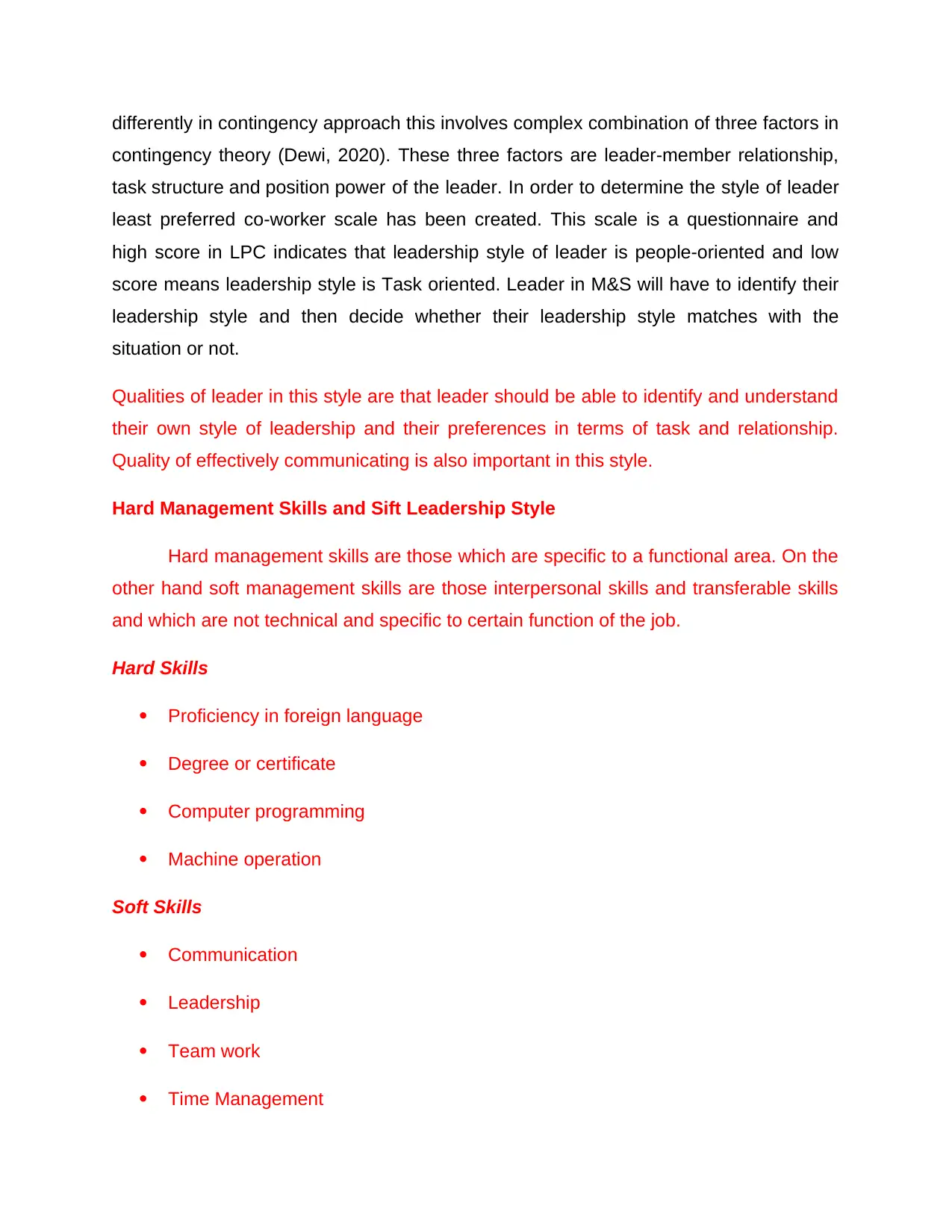
differently in contingency approach this involves complex combination of three factors in
contingency theory (Dewi, 2020). These three factors are leader-member relationship,
task structure and position power of the leader. In order to determine the style of leader
least preferred co-worker scale has been created. This scale is a questionnaire and
high score in LPC indicates that leadership style of leader is people-oriented and low
score means leadership style is Task oriented. Leader in M&S will have to identify their
leadership style and then decide whether their leadership style matches with the
situation or not.
Qualities of leader in this style are that leader should be able to identify and understand
their own style of leadership and their preferences in terms of task and relationship.
Quality of effectively communicating is also important in this style.
Hard Management Skills and Sift Leadership Style
Hard management skills are those which are specific to a functional area. On the
other hand soft management skills are those interpersonal skills and transferable skills
and which are not technical and specific to certain function of the job.
Hard Skills
Proficiency in foreign language
Degree or certificate
Computer programming
Machine operation
Soft Skills
Communication
Leadership
Team work
Time Management
contingency theory (Dewi, 2020). These three factors are leader-member relationship,
task structure and position power of the leader. In order to determine the style of leader
least preferred co-worker scale has been created. This scale is a questionnaire and
high score in LPC indicates that leadership style of leader is people-oriented and low
score means leadership style is Task oriented. Leader in M&S will have to identify their
leadership style and then decide whether their leadership style matches with the
situation or not.
Qualities of leader in this style are that leader should be able to identify and understand
their own style of leadership and their preferences in terms of task and relationship.
Quality of effectively communicating is also important in this style.
Hard Management Skills and Sift Leadership Style
Hard management skills are those which are specific to a functional area. On the
other hand soft management skills are those interpersonal skills and transferable skills
and which are not technical and specific to certain function of the job.
Hard Skills
Proficiency in foreign language
Degree or certificate
Computer programming
Machine operation
Soft Skills
Communication
Leadership
Team work
Time Management
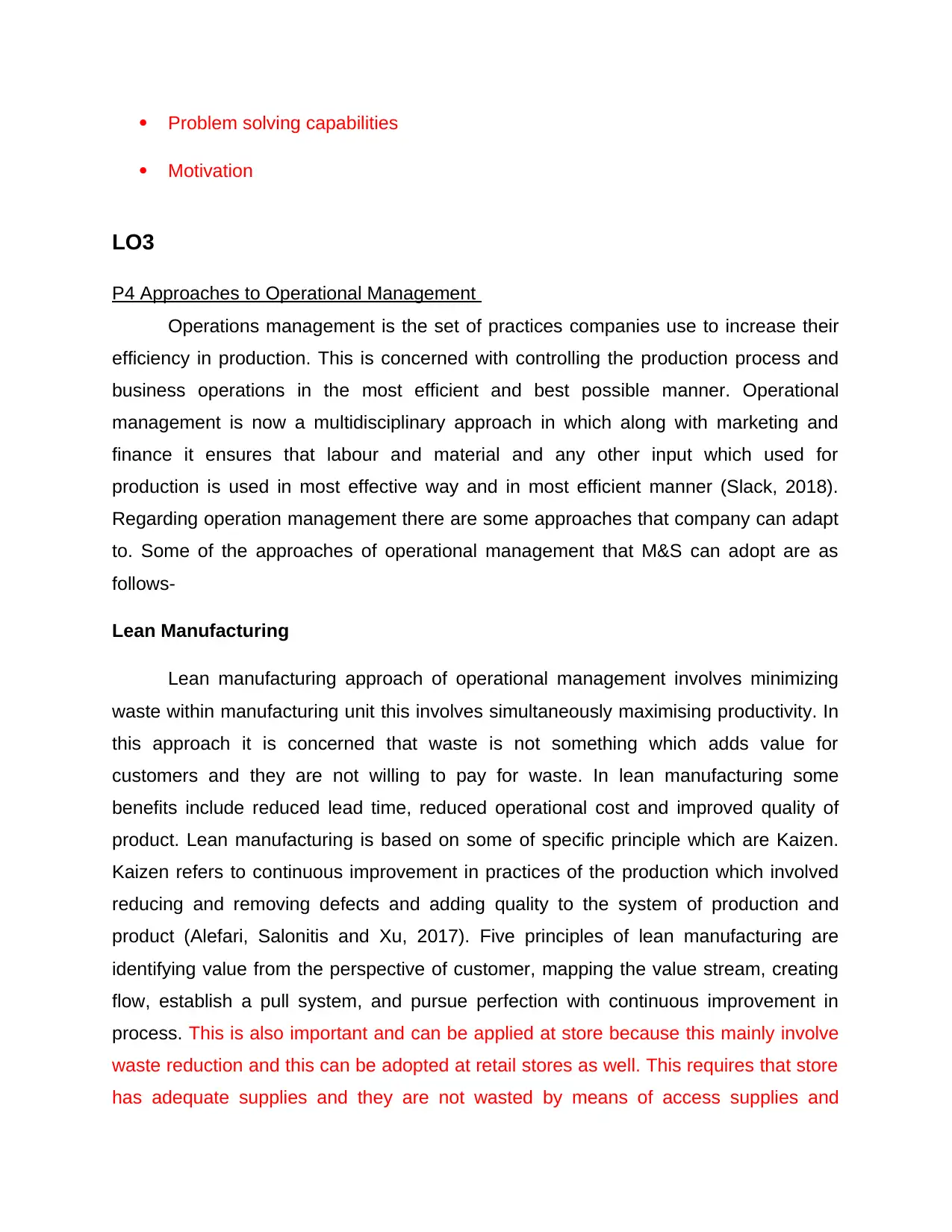
Problem solving capabilities
Motivation
LO3
P4 Approaches to Operational Management
Operations management is the set of practices companies use to increase their
efficiency in production. This is concerned with controlling the production process and
business operations in the most efficient and best possible manner. Operational
management is now a multidisciplinary approach in which along with marketing and
finance it ensures that labour and material and any other input which used for
production is used in most effective way and in most efficient manner (Slack, 2018).
Regarding operation management there are some approaches that company can adapt
to. Some of the approaches of operational management that M&S can adopt are as
follows-
Lean Manufacturing
Lean manufacturing approach of operational management involves minimizing
waste within manufacturing unit this involves simultaneously maximising productivity. In
this approach it is concerned that waste is not something which adds value for
customers and they are not willing to pay for waste. In lean manufacturing some
benefits include reduced lead time, reduced operational cost and improved quality of
product. Lean manufacturing is based on some of specific principle which are Kaizen.
Kaizen refers to continuous improvement in practices of the production which involved
reducing and removing defects and adding quality to the system of production and
product (Alefari, Salonitis and Xu, 2017). Five principles of lean manufacturing are
identifying value from the perspective of customer, mapping the value stream, creating
flow, establish a pull system, and pursue perfection with continuous improvement in
process. This is also important and can be applied at store because this mainly involve
waste reduction and this can be adopted at retail stores as well. This requires that store
has adequate supplies and they are not wasted by means of access supplies and
Motivation
LO3
P4 Approaches to Operational Management
Operations management is the set of practices companies use to increase their
efficiency in production. This is concerned with controlling the production process and
business operations in the most efficient and best possible manner. Operational
management is now a multidisciplinary approach in which along with marketing and
finance it ensures that labour and material and any other input which used for
production is used in most effective way and in most efficient manner (Slack, 2018).
Regarding operation management there are some approaches that company can adapt
to. Some of the approaches of operational management that M&S can adopt are as
follows-
Lean Manufacturing
Lean manufacturing approach of operational management involves minimizing
waste within manufacturing unit this involves simultaneously maximising productivity. In
this approach it is concerned that waste is not something which adds value for
customers and they are not willing to pay for waste. In lean manufacturing some
benefits include reduced lead time, reduced operational cost and improved quality of
product. Lean manufacturing is based on some of specific principle which are Kaizen.
Kaizen refers to continuous improvement in practices of the production which involved
reducing and removing defects and adding quality to the system of production and
product (Alefari, Salonitis and Xu, 2017). Five principles of lean manufacturing are
identifying value from the perspective of customer, mapping the value stream, creating
flow, establish a pull system, and pursue perfection with continuous improvement in
process. This is also important and can be applied at store because this mainly involve
waste reduction and this can be adopted at retail stores as well. This requires that store
has adequate supplies and they are not wasted by means of access supplies and
⊘ This is a preview!⊘
Do you want full access?
Subscribe today to unlock all pages.

Trusted by 1+ million students worldwide
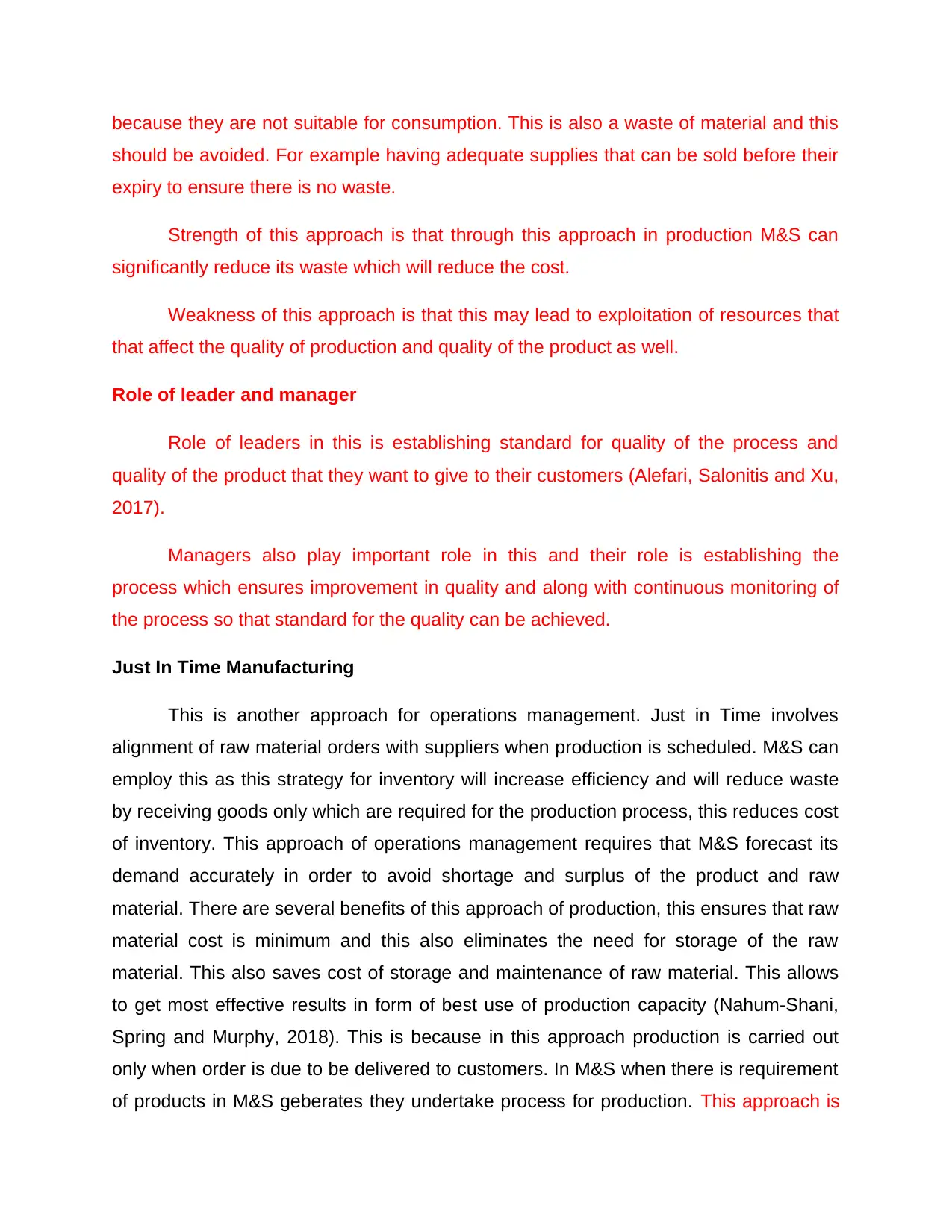
because they are not suitable for consumption. This is also a waste of material and this
should be avoided. For example having adequate supplies that can be sold before their
expiry to ensure there is no waste.
Strength of this approach is that through this approach in production M&S can
significantly reduce its waste which will reduce the cost.
Weakness of this approach is that this may lead to exploitation of resources that
that affect the quality of production and quality of the product as well.
Role of leader and manager
Role of leaders in this is establishing standard for quality of the process and
quality of the product that they want to give to their customers (Alefari, Salonitis and Xu,
2017).
Managers also play important role in this and their role is establishing the
process which ensures improvement in quality and along with continuous monitoring of
the process so that standard for the quality can be achieved.
Just In Time Manufacturing
This is another approach for operations management. Just in Time involves
alignment of raw material orders with suppliers when production is scheduled. M&S can
employ this as this strategy for inventory will increase efficiency and will reduce waste
by receiving goods only which are required for the production process, this reduces cost
of inventory. This approach of operations management requires that M&S forecast its
demand accurately in order to avoid shortage and surplus of the product and raw
material. There are several benefits of this approach of production, this ensures that raw
material cost is minimum and this also eliminates the need for storage of the raw
material. This also saves cost of storage and maintenance of raw material. This allows
to get most effective results in form of best use of production capacity (Nahum-Shani,
Spring and Murphy, 2018). This is because in this approach production is carried out
only when order is due to be delivered to customers. In M&S when there is requirement
of products in M&S geberates they undertake process for production. This approach is
should be avoided. For example having adequate supplies that can be sold before their
expiry to ensure there is no waste.
Strength of this approach is that through this approach in production M&S can
significantly reduce its waste which will reduce the cost.
Weakness of this approach is that this may lead to exploitation of resources that
that affect the quality of production and quality of the product as well.
Role of leader and manager
Role of leaders in this is establishing standard for quality of the process and
quality of the product that they want to give to their customers (Alefari, Salonitis and Xu,
2017).
Managers also play important role in this and their role is establishing the
process which ensures improvement in quality and along with continuous monitoring of
the process so that standard for the quality can be achieved.
Just In Time Manufacturing
This is another approach for operations management. Just in Time involves
alignment of raw material orders with suppliers when production is scheduled. M&S can
employ this as this strategy for inventory will increase efficiency and will reduce waste
by receiving goods only which are required for the production process, this reduces cost
of inventory. This approach of operations management requires that M&S forecast its
demand accurately in order to avoid shortage and surplus of the product and raw
material. There are several benefits of this approach of production, this ensures that raw
material cost is minimum and this also eliminates the need for storage of the raw
material. This also saves cost of storage and maintenance of raw material. This allows
to get most effective results in form of best use of production capacity (Nahum-Shani,
Spring and Murphy, 2018). This is because in this approach production is carried out
only when order is due to be delivered to customers. In M&S when there is requirement
of products in M&S geberates they undertake process for production. This approach is
Paraphrase This Document
Need a fresh take? Get an instant paraphrase of this document with our AI Paraphraser
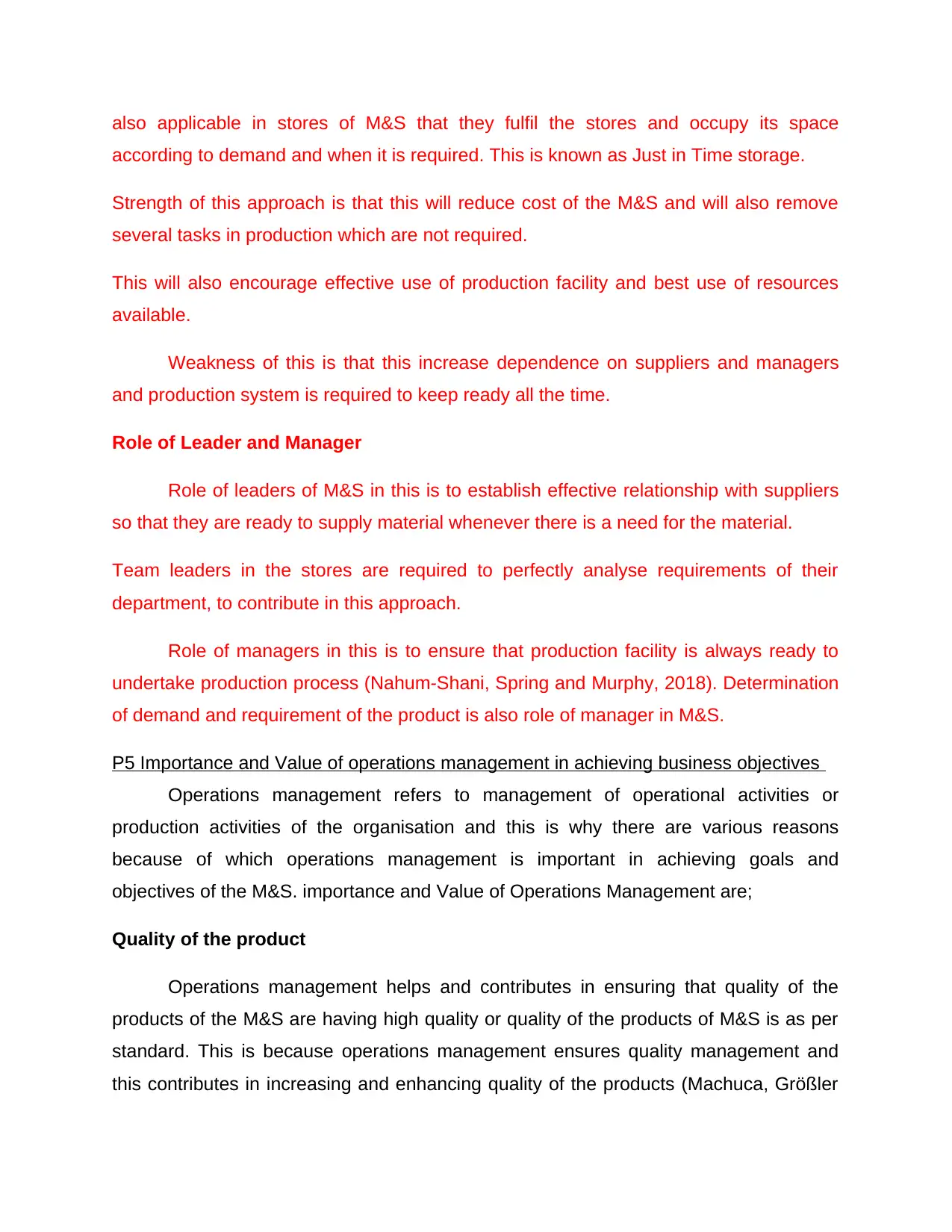
also applicable in stores of M&S that they fulfil the stores and occupy its space
according to demand and when it is required. This is known as Just in Time storage.
Strength of this approach is that this will reduce cost of the M&S and will also remove
several tasks in production which are not required.
This will also encourage effective use of production facility and best use of resources
available.
Weakness of this is that this increase dependence on suppliers and managers
and production system is required to keep ready all the time.
Role of Leader and Manager
Role of leaders of M&S in this is to establish effective relationship with suppliers
so that they are ready to supply material whenever there is a need for the material.
Team leaders in the stores are required to perfectly analyse requirements of their
department, to contribute in this approach.
Role of managers in this is to ensure that production facility is always ready to
undertake production process (Nahum-Shani, Spring and Murphy, 2018). Determination
of demand and requirement of the product is also role of manager in M&S.
P5 Importance and Value of operations management in achieving business objectives
Operations management refers to management of operational activities or
production activities of the organisation and this is why there are various reasons
because of which operations management is important in achieving goals and
objectives of the M&S. importance and Value of Operations Management are;
Quality of the product
Operations management helps and contributes in ensuring that quality of the
products of the M&S are having high quality or quality of the products of M&S is as per
standard. This is because operations management ensures quality management and
this contributes in increasing and enhancing quality of the products (Machuca, Größler
according to demand and when it is required. This is known as Just in Time storage.
Strength of this approach is that this will reduce cost of the M&S and will also remove
several tasks in production which are not required.
This will also encourage effective use of production facility and best use of resources
available.
Weakness of this is that this increase dependence on suppliers and managers
and production system is required to keep ready all the time.
Role of Leader and Manager
Role of leaders of M&S in this is to establish effective relationship with suppliers
so that they are ready to supply material whenever there is a need for the material.
Team leaders in the stores are required to perfectly analyse requirements of their
department, to contribute in this approach.
Role of managers in this is to ensure that production facility is always ready to
undertake production process (Nahum-Shani, Spring and Murphy, 2018). Determination
of demand and requirement of the product is also role of manager in M&S.
P5 Importance and Value of operations management in achieving business objectives
Operations management refers to management of operational activities or
production activities of the organisation and this is why there are various reasons
because of which operations management is important in achieving goals and
objectives of the M&S. importance and Value of Operations Management are;
Quality of the product
Operations management helps and contributes in ensuring that quality of the
products of the M&S are having high quality or quality of the products of M&S is as per
standard. This is because operations management ensures quality management and
this contributes in increasing and enhancing quality of the products (Machuca, Größler
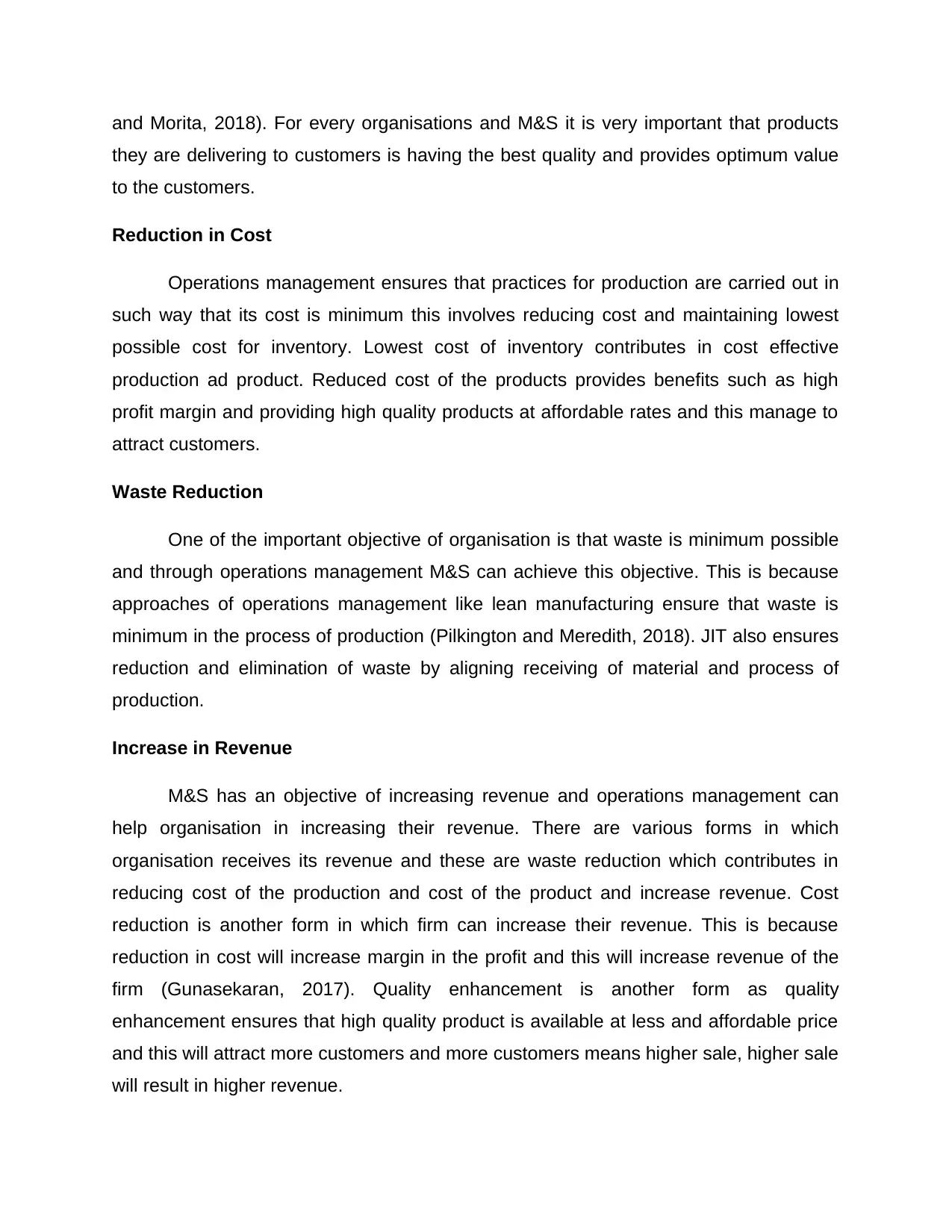
and Morita, 2018). For every organisations and M&S it is very important that products
they are delivering to customers is having the best quality and provides optimum value
to the customers.
Reduction in Cost
Operations management ensures that practices for production are carried out in
such way that its cost is minimum this involves reducing cost and maintaining lowest
possible cost for inventory. Lowest cost of inventory contributes in cost effective
production ad product. Reduced cost of the products provides benefits such as high
profit margin and providing high quality products at affordable rates and this manage to
attract customers.
Waste Reduction
One of the important objective of organisation is that waste is minimum possible
and through operations management M&S can achieve this objective. This is because
approaches of operations management like lean manufacturing ensure that waste is
minimum in the process of production (Pilkington and Meredith, 2018). JIT also ensures
reduction and elimination of waste by aligning receiving of material and process of
production.
Increase in Revenue
M&S has an objective of increasing revenue and operations management can
help organisation in increasing their revenue. There are various forms in which
organisation receives its revenue and these are waste reduction which contributes in
reducing cost of the production and cost of the product and increase revenue. Cost
reduction is another form in which firm can increase their revenue. This is because
reduction in cost will increase margin in the profit and this will increase revenue of the
firm (Gunasekaran, 2017). Quality enhancement is another form as quality
enhancement ensures that high quality product is available at less and affordable price
and this will attract more customers and more customers means higher sale, higher sale
will result in higher revenue.
they are delivering to customers is having the best quality and provides optimum value
to the customers.
Reduction in Cost
Operations management ensures that practices for production are carried out in
such way that its cost is minimum this involves reducing cost and maintaining lowest
possible cost for inventory. Lowest cost of inventory contributes in cost effective
production ad product. Reduced cost of the products provides benefits such as high
profit margin and providing high quality products at affordable rates and this manage to
attract customers.
Waste Reduction
One of the important objective of organisation is that waste is minimum possible
and through operations management M&S can achieve this objective. This is because
approaches of operations management like lean manufacturing ensure that waste is
minimum in the process of production (Pilkington and Meredith, 2018). JIT also ensures
reduction and elimination of waste by aligning receiving of material and process of
production.
Increase in Revenue
M&S has an objective of increasing revenue and operations management can
help organisation in increasing their revenue. There are various forms in which
organisation receives its revenue and these are waste reduction which contributes in
reducing cost of the production and cost of the product and increase revenue. Cost
reduction is another form in which firm can increase their revenue. This is because
reduction in cost will increase margin in the profit and this will increase revenue of the
firm (Gunasekaran, 2017). Quality enhancement is another form as quality
enhancement ensures that high quality product is available at less and affordable price
and this will attract more customers and more customers means higher sale, higher sale
will result in higher revenue.
⊘ This is a preview!⊘
Do you want full access?
Subscribe today to unlock all pages.

Trusted by 1+ million students worldwide
1 out of 17
Related Documents
Your All-in-One AI-Powered Toolkit for Academic Success.
+13062052269
info@desklib.com
Available 24*7 on WhatsApp / Email
![[object Object]](/_next/static/media/star-bottom.7253800d.svg)
Unlock your academic potential
Copyright © 2020–2025 A2Z Services. All Rights Reserved. Developed and managed by ZUCOL.





